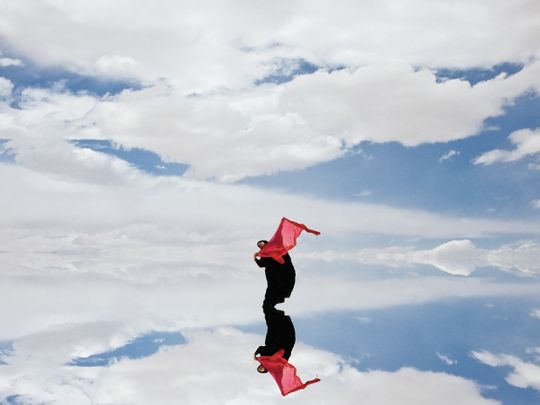
Suffering, persecution and displacement through war are all topics that resonate with Arizona-based artist and photographer Sama Alshaibi. As a Palestinian-Iraqi, whose family were exiled from two homelands, she’s experienced each firsthand and in turn they are reflected in her mesmerising videos and photographs – in particular those from her ‘Silsila’ series. It is work from ‘Silsila’ which has most recently been exhibited as part of the ‘Our Night is Long’ exhibition at Ayyam Gallery in Dubai.

‘Our Night is Long’ is a collaboration of mixed-media pieces from artists Sadik Kwaish Alfraji, Thaier Helal, Rula Halawani, Fathallah Zamroud, Tammam Azzam and Sama, who now works as Professor of Photography and Video Art at the University of Arizona. The collection of photographs and paintings explores the theme of war, violence and conflict in the Middle East with the work depicting the impact on people as well as the affected landscapes, be that through turbulence and fighting or environmental impact. We caught up with Sama, 43, who last month was awarded an Arab Fund for Arts and Culture grant, for her forthcoming project ‘Carry Over’, to discuss the themes of war and conflict in her art.
Citizen K Arabia: The theme of ‘violence and suffering' is not an easy subject to digest, why is a gallery the right space to send this message?
Sama Alshaibi: I believe a gallery, or any space that exhibits contemporary art, should consider its role in highlighting the important issues of our time. We often equate galleries with sales and commercial viability, but they also can be civic spaces where the uncomfortable and timely are given a platform. In the case of ‘Our Night is Long’, Ayyam Gallery has showcased their commitment to such issues because it reflects the values and contexts of their artists.
Does the art world in general give ‘enough time’ to this as a subject?
If enough artists engage in this kind of topic with honesty and passion, I believe the art world will respond. Maybe it sounds a little naïve, but in the end, the ‘art scene’ will respond to strong work with strong ideas. Some artists are living these conditions, or have in the past. They have no choice but to respond to it in their work. That isn’t true for all artists.
How do your pieces in particular fit the theme?
All of my work is based on my own life experience of the double negation of my homelands, Iraq and Palestine, and trying to find a home after war placed me on the outside of anything that was once familiar. Through my work, I try to speak for people like me. I speak from my own context, but I hope it resonates with the experiences of many.

Tell us about your displacement.
I spent my formative years migrating across Middle Eastern countries as a political refugee. My family was blacklisted from Ba’athist Iraq for opposing Saddam Hussein’s government and fleeing during the Iraq/Iran War. I eventually moved to the United States, residing for years as an ‘undocumented person’ when my family overstayed our temporary visa. We had no country willing to accept us, and if were to return to Iraq, our fate would be sealed. We secured the implausible path towards U.S. citizenship by pleading our case in court and were granted asylum. I enrolled at Columbia College, Chicago, to become a war photojournalist stationed in the Middle East. This started my path towards becoming an artist.
Tell us a bit more about the ‘destruction of ecosystems’ element of your pieces.
I’m answering this question today from my home in the USA, as I watch the flooding in Houston, Texas, on the news. This is because of the destruction of ecosystems. Climate change, poor leadership in terms of city planning, and the ongoing quest for more oil instead of safer, renewable energy. It isn’t just Houston, but an attitude that prevails in the age of Global Capitalism. It is easy to spot the spectacle of climate change on the Weather Channel and the 24-hour cable news. Conversely, in my project ‘Silsila’, the end of water is highlighted. It is harder to spot as communities will uproot their lives more gradually. Poverty isn’t always visually dramatic as a hurricane. It might not effect 2 million people all at the same time. But the results are very similar.
What are your feelings on the art scene in Dubai?
I travel there often to exhibit my work and for other cultural and arts opportunities. I feel it is a thriving space that allows risk and supports MENA artists as well as many others not from the region. It is a young scene, growing and changing rapidly, but that is why it remains relevant and exciting.




